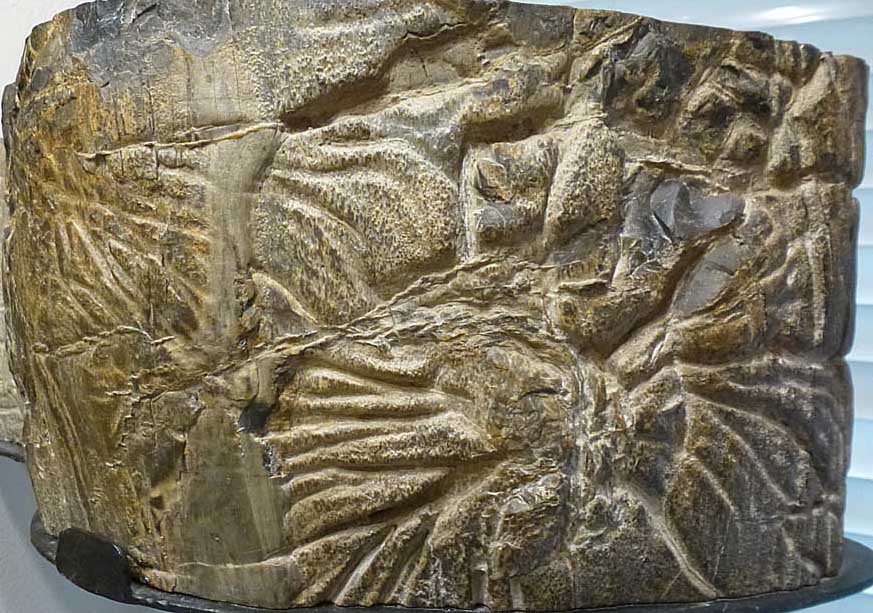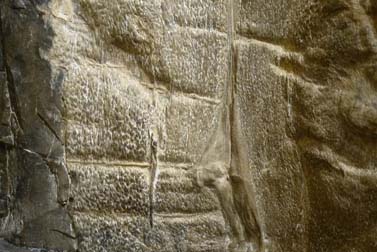Alleged fossil wood burrows
 A fossil tree trunk section with
furrows on its cylindrical surface which
resemble arthropod burrows below the bark of extant coniferous trees
(Fig.1) is shown in [1], there Fig.442, and interpreted there
as evidence of arthropod activity in the Lower Permian. That
interpretation has been refuted in [2] by
means of details from Fig.1.
A fossil tree trunk section with
furrows on its cylindrical surface which
resemble arthropod burrows below the bark of extant coniferous trees
(Fig.1) is shown in [1], there Fig.442, and interpreted there
as evidence of arthropod activity in the Lower Permian. That
interpretation has been refuted in [2] by
means of details from Fig.1.
Fig.1: Lateral view of a fossil tree trunk section, surface area with
furrows formed from
shrinkage cracks, misinterpreted as arthropod
burrows in [1], (there mirror image, erroneous
scale). Height 16.5cm,
Palaeontological Museum Nierstein.
Closer
inspection of the same specimen confirms the early doubts and
thus contradicts the interpretation in [1] once more. Some of
the furrows are V-shaped at the bottom, often
with a slightly protruding ridge along the bottom, as clearly
seen below right and elsewhere. This provides a clue to an
explanation: Furrows of this type could never have been made by
crawling creatures, which suggests that they may
have been brought about by
a combination of a few simple effects involving colloid chemistry
and solid state physics, as outlined in the following.
At an
advanced stage of silicification of the tree trunk, the solid silica
gel shrunk as a result of restructuring from amorphous to partially
microcrystalline. Inhomogeneous shrinkage gave rise
to local tensile stress and narrow cracks. Later the cracks became
filled with silica while deposition continued, a
phenomenon well known as "healing" of the cracks.
(An uncommon but impressive example of crack fills is seen in Fossil
Wood News 17 , Fig.3.)
Apparently the petrified tree trunk had been laid free by erosion of the sediment where it had lain, then
broken into pieces which became tossed about on the beach together
with other pebbles and boulders.
It seems that the healing had not quite
restored the strength of the compact material but has left weak
boundaries along the crack flanks,
hence the healed cracks responded
in particular ways to the impact of pebbles and boulders: Repeated
impacts at or beside a healed crack possibly crushed the crack fill and
caused the nearly parallel crack flanks to recede into
V-shapes, rounded above, as a result of spalling off the edges.
In this way the sculptured surface was
formed from the originally inconspicuous
shrinkage crack pattern extending downward from the surface.
The arrangement of the furrows is not quite compatible with an expected
distribution of shrinkage cracks in plain wood, which may have
contributed to the misinterpretation as arthropod burrows in [1]. This
arrangement must have been governed by some irregularity in the wood which is irrelevant
here. For comparison, shrinkage cracks compatible with the regular wood structure are seen on another area of this trunk surface
(Fig.2).

Fig.2: Surface detail of Permian tree trunk,
same sample and same scale as Fig.1,
furrows less distinct but compatible with the
structure of plain wood,
narrow crack fills seen as ridges along horizontal
furrows: no arthropod borings. Height of the
image 6.8cm,
Annotation: The example considered here is one of many others where lack of due care has led to misinterpretation of fossils.
H.-J. Weiss
2018
[1] R. Rößler:
Der versteinerte Wald von Chemnitz. Museum f. Naturkunde Chemnitz 2001, p.176.
[2] H.-J.
Weiss: Elusive creatures in fossil wood –
Clean-up in the wake of a waning obsession.
www.chertnews.de, Fossil Wood News
16 .
|

|
 29 29 |

 29
29 A fossil tree trunk section with
furrows on its cylindrical surface which
resemble arthropod burrows below the bark of extant coniferous trees
(Fig.1) is shown in [1], there Fig.442, and interpreted there
as evidence of arthropod activity in the Lower Permian. That
interpretation has been refuted in [2] by
means of details from Fig.1.
A fossil tree trunk section with
furrows on its cylindrical surface which
resemble arthropod burrows below the bark of extant coniferous trees
(Fig.1) is shown in [1], there Fig.442, and interpreted there
as evidence of arthropod activity in the Lower Permian. That
interpretation has been refuted in [2] by
means of details from Fig.1.

 29
29